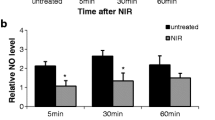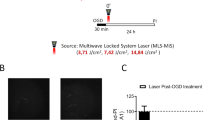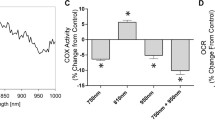Abstract
Near infrared radiation (NIR) is known to penetrate and affect biological systems in multiple ways. Recently, a series of experimental studies suggested that low intensity NIR may protect neuronal cells against a wide range of insults that mimic diseases such as stroke, brain trauma and neurodegeneration. However, the potential molecular mechanisms of neuroprotection with NIR remain poorly defined. In this study, we tested the hypothesis that low intensity NIR may attenuate hypoxia/ischemia-induced mitochondrial dysfunction in neurons. Primary cortical mouse neuronal cultures were subjected to 4 h oxygen-glucose deprivation followed by reoxygenation for 2 h, neurons were then treated with a 2 min exposure to 810-nm NIR. Mitochondrial function markers including MTT reduction and mitochondria membrane potential were measured at 2 h after treatment. Neurotoxicity was quantified 20 h later. Our results showed that 4 h oxygen-glucose deprivation plus 20 h reoxygenation caused 33.8 ± 3.4 % of neuron death, while NIR exposure significantly reduced neuronal death to 23.6 ± 2.9 %. MTT reduction rate was reduced to 75.9 ± 2.7 % by oxygen-glucose deprivation compared to normoxic controls, but NIR exposure significantly rescued MTT reduction to 87.6 ± 4.5 %. Furthermore, after oxygen-glucose deprivation, mitochondria membrane potential was reduced to 48.9 ± 4.39 % of normoxic control, while NIR exposure significantly ameliorated this reduction to 89.6 ± 13.9 % of normoxic control. Finally, NIR significantly rescued OGD-induced ATP production decline at 20 min after NIR. These findings suggest that low intensity NIR can protect neurons against oxygen-glucose deprivation by rescuing mitochondrial function and restoring neuronal energetics.




Similar content being viewed by others
References
Anders JJ et al (2004) Phototherapy promotes regeneration and functional recovery of injured peripheral nerve. Neurol Res 26:233–239
Berridge MV et al (2005) Tetrazolium dyes as tools in cell biology: new insights into their cellular reduction. Biotechnol Annu Rev 11:127–152
Brosseau, L., et al., 2005. Low level laser therapy (Classes I, II and III) for treating rheumatoid arthritis. Cochrane Database Syst Rev. CD002049
Byrnes KR et al (2005) Light promotes regeneration and functional recovery and alters the immune response after spinal cord injury. Lasers Surg Med 36:171–185
Cavalier-Smith T (2006) Origin of mitochondria by intracellular enslavement of a photosynthetic purple bacterium. Proc Biol Sci 273:1943–1952
Chen LB (1988) Mitochondrial membrane potential in living cells. Annu Rev Cell Biol 4:155–181
De Taboada L et al (2011) Transcranial laser therapy attenuates amyloid-beta peptide neuropathology in amyloid-beta protein precursor transgenic mice. J Alzheimers Dis 23:521–535
Duan R et al (2001) Signal transduction pathways involved in low intensity He-Ne laser-induced respiratory burst in bovine neutrophils: a potential mechanism of low intensity laser biostimulation. Lasers Surg Med 29:174–178
Eells JT et al (2003) Therapeutic photobiomodulation for methanol-induced retinal toxicity. Proc Natl Acad Sci USA 100:3439–3444
Friedmann H et al (1991) A possible explanation of laser-induced stimulation and damage of cell cultures. J Photochem Photobiol B 11:87–91
Huang, Y. Y., et al., 2013a. Low-level laser therapy (810 nm) protects primary cortical neurons against excitotoxicity in vitro. J Biophotonics
Huang YY et al (2013b) Low-level laser therapy (LLLT) reduces oxidative stress in primary cortical neurons in vitro. J Biophotonics 6:829–838
Karu T (1999) Primary and secondary mechanisms of action of visible to near-IR radiation on cells. J Photochem Photobiol B 49:1–17
Khuman J et al (2012) Low-level laser light therapy improves cognitive deficits and inhibits microglial activation after controlled cortical impact in mice. J Neurotrauma 29:408–417
Lapchak PA et al (2004) Transcranial infrared laser therapy improves clinical rating scores after embolic strokes in rabbits. Stroke 35:1985–1988
Leung MC et al (2002) Treatment of experimentally induced transient cerebral ischemia with low energy laser inhibits nitric oxide synthase activity and up-regulates the expression of transforming growth factor-beta 1. Lasers Surg Med 31:283–288
Liu J et al (2009) Effects of neuroglobin overexpression on mitochondrial function and oxidative stress following hypoxia/reoxygenation in cultured neurons. J Neurosci Res 87:164–170
Majem M et al (2006) Does induction chemotherapy still have a role in larynx preservation strategies? The experience of Institut Catala d’Oncologia in stage III larynx carcinoma. Laryngoscope 116:1651–1656
Morimoto Y et al (2013) Low level laser therapy for sports injuries. Laser Ther 22:17–20
Moriyama Y et al (2005) In vivo study of the inflammatory modulating effects of low-level laser therapy on iNOS expression using bioluminescence imaging. Photochem Photobiol 81:1351–1355
Oron A et al (2006) Low-level laser therapy applied transcranially to rats after induction of stroke significantly reduces long-term neurological deficits. Stroke 37:2620–2624
Oron A et al (2007) low-level laser therapy applied transcranially to mice following traumatic brain injury significantly reduces long-term neurological deficits. J Neurotrauma 24:651–656
Peplow PV et al (2010) Laser photobiomodulation of wound healing: a review of experimental studies in mouse and rat animal models. Photomed Laser Surg 28:291–325
Plaetzer K et al (2002) Characterization of the cell death modes and the associated changes in cellular energy supply in response to AlPcS4-PDT. Photochem Photobiol Sci 1:172–177
Sharma SK et al (2011) Dose response effects of 810 nm laser light on mouse primary cortical neurons. Lasers Surg Med 43:851–859
Wang X et al (2002) Hemoglobin-induced cytotoxicity in rat cerebral cortical neurons: caspase activation and oxidative stress. Stroke 33:1882–1888
Wang, X. Y., et al., 2013. Effect of low-level laser therapy on allergic asthma in rats. Lasers Med Sci
Wu Q et al (2012) Low-level laser therapy for closed-head traumatic brain injury in mice: effect of different wavelengths. Lasers Surg Med 44:218–226
Xavier M et al (2010) Anti-inflammatory effects of low-level light emitting diode therapy on Achilles tendinitis in rats. Lasers Surg Med 42:553–558
Xuan W et al (2013) Transcranial low-level laser therapy improves neurological performance in traumatic brain injury in mice: effect of treatment repetition regimen. PLoS One 8:e53454
Yu Z et al (2009) Neuroglobin-overexpression alters hypoxic response gene expression in primary neuron culture following oxygen glucose deprivation. Neuroscience 162:396–403
Author information
Authors and Affiliations
Corresponding authors
Rights and permissions
About this article
Cite this article
Yu, Z., Liu, N., Zhao, J. et al. Near infrared radiation rescues mitochondrial dysfunction in cortical neurons after oxygen-glucose deprivation. Metab Brain Dis 30, 491–496 (2015). https://doi.org/10.1007/s11011-014-9515-6
Received:
Accepted:
Published:
Issue Date:
DOI: https://doi.org/10.1007/s11011-014-9515-6




